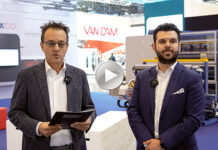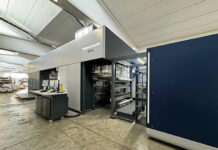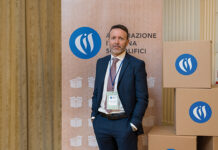Last October 25, Turin, the capital of Corporate Culture 2024, hosted the Giflex autumn conference, a day with many and varied food for thought, for a broad overview, well beyond the boundaries of flexible packaging, a healthy, growing sector with a strong propensity for innovation in terms of sustainability
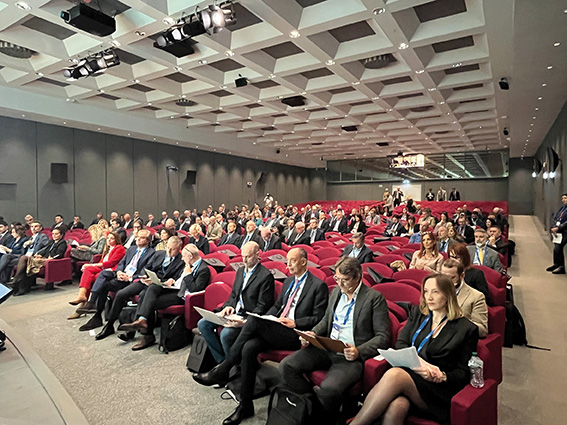
Over 250 operators filled the conference room of the Industrial Union of Turin, which hosted the traditional autumn meeting of Giflex, the Flexible Packaging Group within Assografici, last October, closing a year of very intense commitments and preparing for an equally explosive 2025 that will have an important moment of celebration during next Ipack-ima in Milan when Giflex will celebrate 40 years of activity. There was a great moment of general emotion when Alberto Palaveri remembered the figure of Jonathan Giubilato of BOBST who tragically passed away last summer, accompanied by a long and warm applause from the present audience.
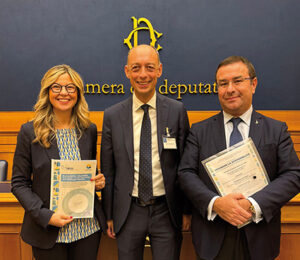
Data from the flexible packaging sector
The flexible packaging sector confirms itself as a solid and healthy sector, certainly with many challenges ahead, but faced with determination, also thanks to the commitment of Giflex. In Italy the sector employs over 12 thousand people, for a turnover of over €4.5 billion. The companies in the sector are changing their skin, and are focused on production, but the entry of new professional figures in the design and planning sector is increasingly frequent.
“We are a solid and healthy sector. Although the 2023 financial statements indicate that, after the boom of the previous two years, the value of the turnover is contracting, the number of employees continues to increase and the financial strength of our companies is growing, also thanks to the drop in the costs of raw materials and energy”, commented Alberto Palaveri, president of Giflex, also underlining the fact that with an Ebitda above 10%, flexible packaging manufacturers are above the average of Italian manufacturing.
The consumption of flexible packaging in Western Europe is approximately 12% of the global consumption of flexible packaging. Emerging markets (Africa, Asia, Far East) are those that are growing the most and today consume more than 50% of the global production of flexible.
In 2023 there was a decline in turnover after years of continuous expansion, nevertheless the volumes of flexible continue to record constant growth for several years with an annual increase of a few percentage points.
It is therefore important to continue to tell the story of the value and identity of the flexible packaging industry, a highly technological sector that works behind the scenes of major brands, designing iconic packs of our times.
Flexible space packaging
Storytelling is another of the key points on which Giflex is insisting a lot to make known, outside of the industry, what flexible packaging is and what values and the contribution that a package can guarantee in the consumer experience.
In an Italy that reads less and less, packaging is undoubtedly one of the most read media and this is one of the main reasons why companies are willing to invest in renewing the dress that packs their products. The GDO Bennet chain recently created a campaign entitled “Good To Read Packs”, transforming food packages into pages of branded products, into great classics of literature and best sellers of the moment, in order to promote reading among consumers.
We do not know if our most famous astronauts brought books to read on their space missions, but we certainly know that Nespoli, Parmitano and Cristoforetti were able to enjoy dehydrated Italian food on their missions thanks to a special flexible packaging.
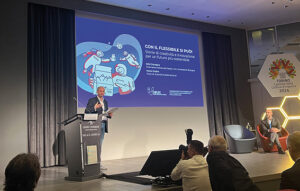 This extraordinary case history was told by Erik Ciravegna, researcher at the Advanced Design Unit at the University of Bologna, and Marco Scatto, Polymer Scientist at Sudalimenta, owner of the Tiberino brand, which developed these special flexible packages to carry food into space from Puglia. Starting from the assumption that living conditions on a space mission subject astronauts to considerable psychophysical stress, an attempt was made to partially compensate for these deficiencies through food, offering Italian astronauts customized menus based on their geographical origins, thanks to a flexible bag capable of preserving dehydrated food for a long time without altering its color, fragrance and taste. From a technical point of view, it is a lightweight laminated mono-material capable of guaranteeing a barrier to oxygen and water, sealable, antimicrobial, resistant to shocks and ionizing radiation, as well as guaranteeing functionality from the addition of water to its use as a container.
This extraordinary case history was told by Erik Ciravegna, researcher at the Advanced Design Unit at the University of Bologna, and Marco Scatto, Polymer Scientist at Sudalimenta, owner of the Tiberino brand, which developed these special flexible packages to carry food into space from Puglia. Starting from the assumption that living conditions on a space mission subject astronauts to considerable psychophysical stress, an attempt was made to partially compensate for these deficiencies through food, offering Italian astronauts customized menus based on their geographical origins, thanks to a flexible bag capable of preserving dehydrated food for a long time without altering its color, fragrance and taste. From a technical point of view, it is a lightweight laminated mono-material capable of guaranteeing a barrier to oxygen and water, sealable, antimicrobial, resistant to shocks and ionizing radiation, as well as guaranteeing functionality from the addition of water to its use as a container.
LCA Giflex: a call to the supply chain to complete the study
October was an important month for Giflex, which presented the LCA guidelines as a useful tool for companies to measure the sustainability of the packaging produced. This initiative was made possible thanks to the Hon. Maria Chiara Gadda, Vice President of the Agriculture Commission of the Chamber of Deputies and interlocutor for some years for Giflex: the aim is raising awareness among the legislator, both Italian and European, to promote an environmental policy that combines innovation and sustainability.
Andrea Cassinari, Coordinator of the Giflex Scientific Committees and Paola Riccardi, Packaging Consultant SRC Ingegneria, explained these LCA Guidelines which in any case represent a starting point and must absolutely be refined as regards the operational standards and materials actually used by the flexible industry. This first publication took into consideration the production of two secondary packages, and it appears evident that, with equal materials and performance, lighter structures guarantee lower emissions, underlining the importance of ecodesign already in the design phase. The goal for the immediate future will be to also consider the post-production phase, considering the end-of-life of the packaging to have a complete overview of the LCA.
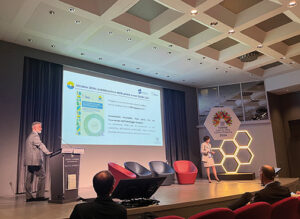 Cassinari then drew attention to a crucial point for Giflex associates, who as is known, have their core business in materials in contact with food. To ensure circularity in the process, it is essential for Giflex to be able to exploit chemical recycling that could provide a good quality secondary raw material. “If we analyze the packaging materials released for consumption, we note that polyolefins are the most used, and if we were able to make them available to converters again through chemical recycling, then we could measure the LCA, closing the circle of circularity”, adds Andrea Cassinari, also highlighting that an attempt will be made to organize a working table in this sense with other organizations such as Unionfood, Ucima, Corepla and Conai to talk together about this objective.
Cassinari then drew attention to a crucial point for Giflex associates, who as is known, have their core business in materials in contact with food. To ensure circularity in the process, it is essential for Giflex to be able to exploit chemical recycling that could provide a good quality secondary raw material. “If we analyze the packaging materials released for consumption, we note that polyolefins are the most used, and if we were able to make them available to converters again through chemical recycling, then we could measure the LCA, closing the circle of circularity”, adds Andrea Cassinari, also highlighting that an attempt will be made to organize a working table in this sense with other organizations such as Unionfood, Ucima, Corepla and Conai to talk together about this objective.
Finally, a call to the entire packaging supply chain, from printers and converters, but also producers of technologies and above all materials, so that they can provide precise data on the materials actually used by the industry for the production of flexible packaging.
“The ink we considered for the LCA study is used in gravure for editions, but in the absence of a reference data, we had to accept a compromise”, concludes Cassinari, underlining that there is a need to photograph our world with products and technologies that are actually used in production. The publication demonstrates how much commitment there is on the part of the industries in the sector, but it is essential to expand collaborations to promote a true scientific culture of sustainability.
“This publication is the demonstration that the commitment of the flexible packaging manufacturing industries towards a concrete and necessary change is real and promotes a scientific culture of sustainability. Furthermore, the European PPWR Regulation (Packaging and Packaging Waste Regulation) has taught us that teamwork wins and how important it is to play in advance and not in defense. In the future, the competitiveness of our companies will be played on virtuous models and solutions for the environment. We represent a highly technological sector that works behind the scenes of the big brands. Our packs are icons of our times. Precisely for this reason we want to be bearers of a scientific culture of sustainability”, concluded Palaveri.
Technical contributions by sponsors Windmöller & Hölscher and I&S Gama Group
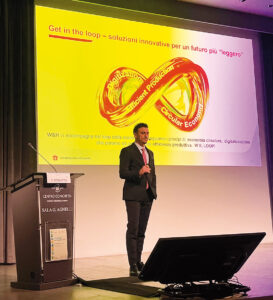
Fabio Gonzatto, Area Sales & Marketing Manager Italy – Printing Machines at W&H, presented the “Innovative Solutions for a “lighter” future thanks to know-how based on over 150 years of history. WH& has always been involved in the flexible packaging sector and boasts a team of 900 engineers and over 1700 registered patents. The German manufacturer, involved in the entire packaging production cycle, from the production of films with extruders, to the flexo and gravure printing lines, has developed its own strategy aimed at recycling and recovering waste materials for the creation of new products. “Paper and plastic are part of our business”, says Gonzatto, “we were born with paper and given how the market is evolving we will continue to develop solutions for this sector, but we produce plastic and we aim to improve it, especially with regard to sustainability”. Various applications were presented, all aimed at producing mono-material packaging with barrier properties and with W&H technologies. “Barrier lacquers represent an economical system for printers to enter the barrier packaging sector. There is no need to have extruders, the costs are comparable to EVOH solutions and it is possible to apply them on films via flexo or gravure machines with dedicated modules”, adds Gonzatto, recalling that W&H has also launched a proprietary platform called ruby that collects and processes big data, interfaces with ERP/MES and also includes AI functions.
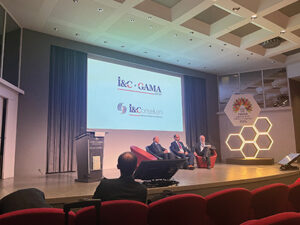
Automation and Big Data in the production process were also discussed in the round table with Sante Conselvan, Managing Director I&C-Gama Group and Firas Marsi, Sales Director SisTrade. The two partners presented the advantages offered by technology, automation and the industrial evolutionary process, with particular attention to the environmental impact. I&C-Gama has its core business in viscometers for fluid control. Over the years, a lot of data has been collected from these systems, but also from other technologies present in the range of products and solutions for printing and converting, which have pushed I&C-Gama to also include a company like SisTrade, a leader in software solutions for data management throughout the production process for the printing and converting sector. Finally, Sante Conselvan, with the energy and enthusiasm that have always distinguished him, closed his speech by launching a challenge, the “Packaging Campus”, a place in Italy where staff for companies in the sector can be trained. “My dream is to launch an Italian training center on printing and packaging techniques for process operators, and to do this we need the contribution of all the players in the supply chain”, concluded Conselvan.





